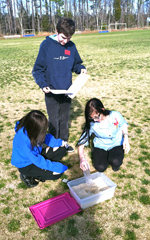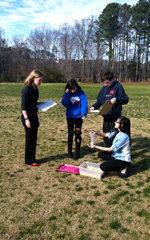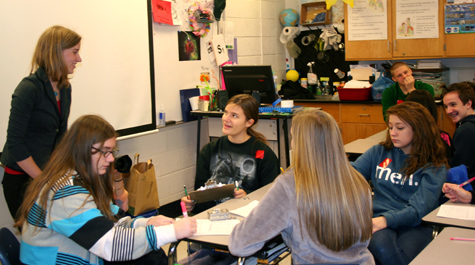VIMS student helps York High class find “Mysteries in the Mud”
Ask a high school freshman whether they would rather sit in a classroom or go outside on a scavenger hunt, and the answer would likely be as clear as a sunny sky.
Kristin Kelly’s 9th-grade Earth Science class at
York High School got a chance to go outside last week when VIMS Ph.D. student
and PERFECT/GK12 Fellow Christina Pondell led them on a scavenger hunt that offered
insight into her research and the opportunity to discover new things about the
area in which they live.
The PERFECT program, for Partnership between Educators and Researchers for Enhancing Classroom Teaching, is funded by the National Science Foundation’s GK-12 program, which supports fellowships and training for graduate students in science, technology, engineering, and mathematics (STEM) through interactions with teachers and students in K-12 schools. PERFECT is the only marine science-focused GK-12 program in the Chesapeake Bay region.
Pondell, who’s studying the accumulation of organic carbon in dam reservoirs, is serving as a GK-12 fellow for the second time, spending at least 10 hours of classroom time per week at York High School in Yorktown. Last year, she was a fellow at Booker T. Washington Middle School in Newport News. Pondell is in the fifth year of her graduate program in the College of William and Mary’s School of Marine Science at VIMS.
“This is what I do for work,” Pondell explained to the class at the beginning of her lesson. “I use biomarkers to study sediment behind dams, so we are going to look at small molecules that may have come from humans, or even dinosaurs.”
Biomarkers are “chemical fossils” that can provide insight into the geologic history of an area, as well as any human impacts. Pondell is using biomarkers to study how dams may have altered the input of organic carbon into coastal habitats. Organic carbon is the currency of energy exchange within ecosystems, so any changes in its availability can have major effects on marine food webs.
During Pondell’s lesson—“Mysteries in the Mud”—she split the class into groups and led them outside to visit several stations where the students searched for different-colored marbles that represented biomarkers from different sources. They then compiled and analyzed their results to reach a conclusion.
Freshman Cody Coberly says the scavenger hunt was by far his
favorite part about Pondell coming in and teaching the class. “We got to find
things that used to be here and I learned new things about where I live,” he
says. “It was fun working as a group with my classmates and solving problems.” 
“We’ve really enjoyed when Ms. Pondell has come to teach our class,” says freshman Summer Wilson. “We’ve definitely learned a lot from her.”
The PERFECT/GK12 program was begun in 2009 by VIMS professors Kam Tang and Iris Anderson, along with Virginia Sea Grant educator Vicki Clark. It is now co-managed by marine education specialist Carol Hopper-Brill of the Marine Advisory Services program at VIMS. “The goal of the program is to provide the fellow with classroom teaching experience, while enriching the STEM content and instruction in partnering schools,” says Tang.
PERFECT has nine fellows per year who are partnered with a teacher at one of five local schools. In addition to York High School and Booker T. Washington Middle School, partnering schools include Grafton High School (Yorktown), Page/Peasley Middle School (Gloucester), and Chesapeake Bay Governor’s School (Glenns/Tappahannock).
Kelly, who has been involved with the program for four years and has worked with two other fellows from VIMS, says “It’s really cool to see the kids get into the lessons and how excited they are to be outside and doing hands-on activities. It’s awesome having another person there to help you with an activity as well, it makes it a lot easier and brings in new ideas.”
“The teacher, the fellow, and the students benefit from having a real-life scientist in the classroom who enriches and improves the STEM content, brings real-life science experience, new lesson-plan ideas, and resources,” says Tang. “The students look to the fellows as role models who may inspire them to pursue a future in science.”
Pondell says she has gained a lot more from the program than she ever expected, including confidence in public speaking and enhanced creativity. “This program has made me able to come up with so many ideas on how to help bring earth science alive for the students, and I’m really proud of the lessons I put together—with the help of my lab group—that use my data to teach concepts important to earth science.”
Kelly has shared her knowledge of teaching techniques and classroom management with Pondell, and was also given the opportunity to learn from Pondell by working with her last summer in her lab at VIMS. “The experience helped Ms. Kelly put the units of measure they talk about in class into perspective and to see the scientific method in action,” says Pondell.
“Working with the students reminds me to take a step back from my research and take a look at the big picture, which can be so hard to do when you spend so many hours focusing on a relatively small project,” she says. “While being in the classroom is always demanding, and sometimes quite exhausting, I always feel refreshed when I return back to my research.”
This year’s other GK-12 fellows are Samantha Bickel (York High), Todd Clardy and Carissa Wilkerson (Booker T. Washington Middle School); Matt Freedman and Jenna Luek (Chesapeake Bay Governor’s School); Ben Marcek and Jenna Spackeen (Grafton High School); and Brandon Conroy, Gar Secrist, and Diane Tulipani (Page/Peasley Middle School).





